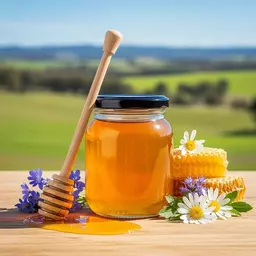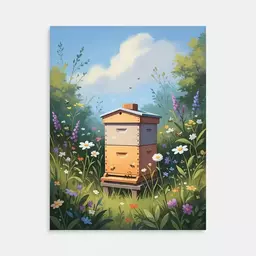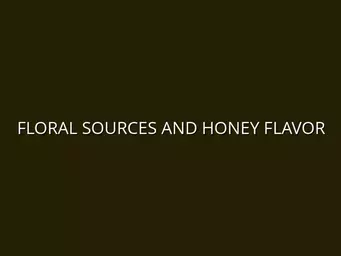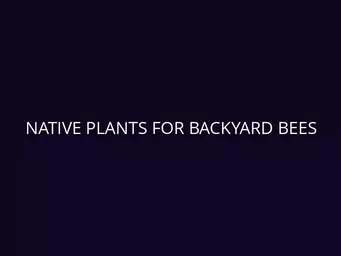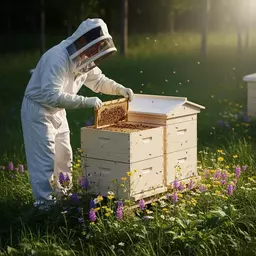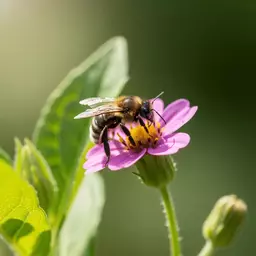Nectar Network: Native Bees Explained
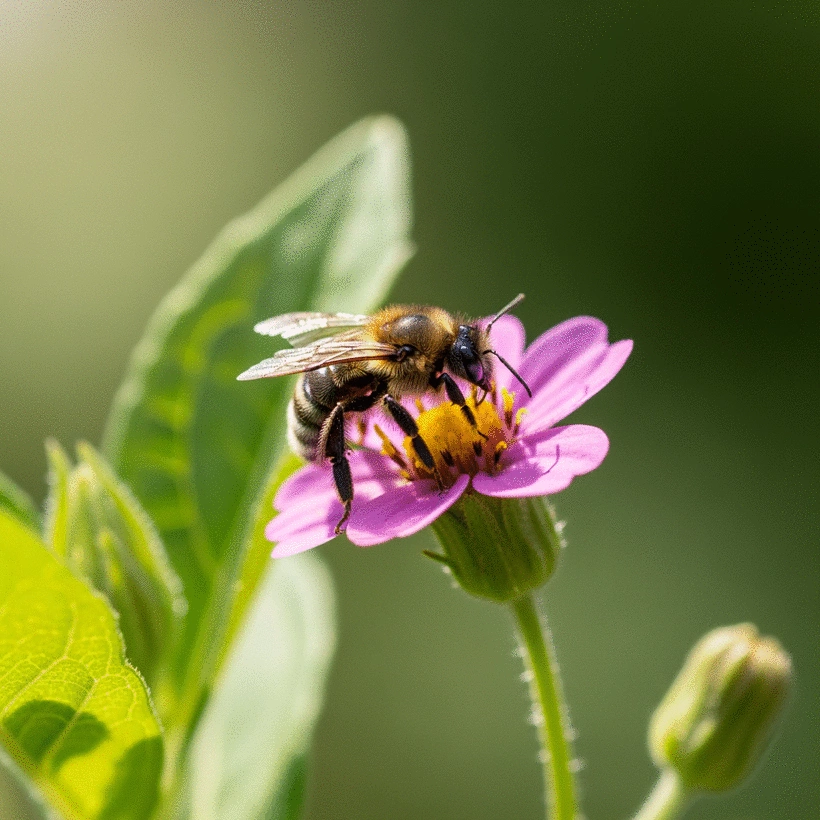
Have you ever considered the pivotal role that native bees play in our ecosystems? These often-overlooked pollinators are not just essential; they are the backbone of biodiversity and food production. Let's dive into what makes them truly remarkable.
What You Will Learn
- There are over 4,000 species of native bees in North America, each uniquely adapted to their environments.
- Native bees often outperform honeybees in pollination efficiency due to their specialized adaptations and behaviors.
- A significant difference between native and honeybees is their social structure; most native bees are solitary, allowing them to thrive in diverse habitats.
- Challenges such as habitat loss, pesticide use, and climate change threaten native bee populations, necessitating conservation efforts.
Comparing Native Bees and Honeybees
This visual highlights key differences and shared threats between native bees and honeybees, underscoring their unique roles and common challenges.
Native Bees: Diversity & Efficiency
- ✓ 4,000+ Species: High diversity (e.g., bumblebees, solitary, sweat bees).
- ✓ Pollination Efficiency: Specialized methods (e.g., buzz pollination for tomatoes).
- ✓ Social Structure: Mostly solitary, not reliant on large colonies.
- ✓ Habitat: Thrive in diverse, local environments.
Honeybees: Social & Managed
- ● Single Species: Apis mellifera, often managed for honey production.
- ● General Pollinators: Effective, but less specialized than many native bees.
- ● Social Structure: Live in large, organized colonies and hives.
- ● Habitat: Often require managed colonies and specific environments.
Shared Challenges & Threats
- ⚠ Habitat Loss: Urbanization & agricultural expansion reduce natural landscapes.
- ⚠ Pesticide Use: Chemicals harm beneficial insects, impacting foraging & reproduction.
- ⚠ Climate Change: Disrupts ecosystems, flowering times, and food availability.
The Essential Role of Native Bees in Our Ecosystems
As I delve into the world of bees, I can’t help but feel a deep appreciation for our native bee species. These incredible creatures play a vital role in pollinating a wide array of plants, thus supporting our ecosystems and food production. Understanding their diversity and efficiency is the first step in recognizing the significance of these tiny pollinators! For those looking to support pollinators, finding bee-friendly seeds in Australia is a great starting point.
Native bees, unlike their more famous relatives, honeybees, are often overlooked. However, they contribute immensely to maintaining biodiversity and the health of our landscapes. In this section, let’s explore the diversity of native bees and how they differ from honeybees, as well as the specific roles they play in pollination.
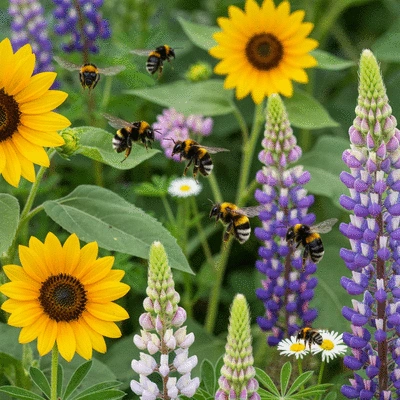
Understanding Native Bee Diversity and Pollination Efficiency
When we think about bees, the image of honeybees in their hives usually comes to mind. However, there are over 4,000 species of native bees in North America alone, each uniquely adapted to their environment. These species include bumblebees, solitary bees, and even sweat bees! The variety in their behaviors and lifecycles influences their pollination efficiency.
- Bumblebees: Known for their size and fuzzy bodies, they are excellent at pollinating larger flowers.
- Solitary Bees: These include mason bees and leafcutter bees, who often specialize in specific plants.
- Sweat Bees: Named for their attraction to human sweat, they are small but efficient pollinators!
Understanding this diversity allows us to appreciate how native bees can enhance pollination efficiency compared to non-native species. Their unique adaptations make them wonderfully effective at transferring pollen, ensuring plants can reproduce successfully. To learn more about general bee care, consider a beginner's guide to honey bees.
Overview of Native Bee Species and Their Importance
Each native bee species plays a crucial role in our ecosystems. They are often more effective pollinators than honeybees because they can access flowers that honeybees cannot. For instance, some native bees can buzz pollinate, which is essential for plants like tomatoes and blueberries. This specialized form of pollination helps increase fruit yield and overall plant health!
By fostering native bee populations, we can enhance the resilience of our ecosystems. Their role extends beyond just pollination; they contribute to the overall biodiversity, which is vital for a balanced environment. As we work towards sustainable practices at Nectar Network, recognizing the importance of these native species is fundamental.
Differences Between Native Bees and Honeybees
One of the key differences between native bees and honeybees lies in their social structures. While honeybees live in large, organized colonies, most native bees are solitary. This means they do not rely on a hive for survival, which allows them to forage in various habitats. Additionally, native bees often have shorter lifecycles, making them well-suited to local environmental conditions.
- Social Structure: Honeybees are social; native bees are often solitary.
- Habitat Preferences: Native bees thrive in diverse environments, whereas honeybees require managed colonies.
- Pollination Techniques: Native bees may have specialized methods for pollination that honeybees lack.
This distinction is crucial as we advocate for conservation and sustainable practices. By understanding these differences, we can tailor our approaches in supporting both native bees and honeybees effectively.
Identifying Common Native Bee Species and Their Roles in Pollination
To foster a thriving environment for native bees, it’s essential to know which species are common in your area and what their specific roles are in pollination. For example, mason bees are excellent early spring pollinators, while bumblebees are active later in the season. Here are a few common native species to look out for:
- Mason Bees: Great for early fruit blossoms.
- Bumblebees: Ideal for large flowers and crop plants.
- Leafcutter Bees: Essential for many native plants.
By identifying and supporting these species, we can create environments that not only attract them but also enhance their pollination effectiveness. This not only benefits the bees but also enriches our gardens and local ecosystems!
Challenges Facing Native Bees and Their Habitats
Despite their crucial roles, native bees face numerous challenges that threaten their populations. Let’s explore the major threats to their habitats and well-being in the next section, as understanding these challenges is vital in our journey toward bee conservation.
Interactive Poll: Your Thoughts on Native Bees
As we explore the challenges facing native bees, we want to hear from you! What do you believe is the most significant threat to native bee populations in your area?
Challenges Facing Native Bees and Their Habitats
As I dive deeper into the world of native bees, I can’t help but feel a sense of urgency about the challenges they face. Understanding these threats is crucial in our quest to support these essential pollinators. Native bees play an invaluable role in maintaining biodiversity and ensuring our ecosystems thrive, but they are facing significant hurdles.
From habitat loss to harmful pesticides, the pressures on native bee populations are mounting. I encourage you to reflect on how these factors might be impacting your local environment. Let’s explore some of the major challenges that threaten our buzzing friends!
Identifying Major Threats to Native Bee Populations
As we work together to create a better habitat for native bees, it's vital to recognize the primary threats they encounter. Here are some of the most pressing challenges:
- Habitat Loss: Urban development and agricultural expansion have led to significant loss of natural habitats.
- Pesticide Use: Chemicals used in conventional farming practices can have devastating effects on bee populations.
- Climate Change: Fluctuating weather patterns disrupt the delicate balance of ecosystems, affecting food sources for bees.
Each of these threats contributes to the decline of native bee populations, making it crucial for us to advocate for change. By understanding these challenges, we can better support efforts aimed at conservation and restoration. This is also important for maintaining sustainable beekeeping for healthy hives.
Impact of Habitat Loss and Urbanization
 Habitat loss is one of the most significant threats to native bees. As cities expand, natural landscapes are replaced with concrete and asphalt. Did you know that even small green spaces can make a difference? Creating urban gardens or preserving local parks can provide critical habitats for bees.
Habitat loss is one of the most significant threats to native bees. As cities expand, natural landscapes are replaced with concrete and asphalt. Did you know that even small green spaces can make a difference? Creating urban gardens or preserving local parks can provide critical habitats for bees. Urbanization often leads to fragmented habitats, making it difficult for bees to find food and nesting sites. By working together to protect and restore these areas, we can create a more welcoming environment for our pollinator friends!
The Role of Pesticides and Climate Change in Pollinator Decline
Pesticides have a complex relationship with bee health. While they are designed to eliminate pests, they can also harm beneficial insects. Some studies indicate that certain pesticides impair bees' ability to forage and reproduce. It's essential to advocate for safer alternatives that protect our precious pollinators.
Moreover, climate change exacerbates these issues. Changes in temperature and precipitation patterns can alter flowering times and food availability. As stewards of the environment, we have the power to advocate for sustainable practices that mitigate these impacts!
Understanding Pesticide Effects on Pollinator Health
Understanding the specific effects of pesticides on native bees can help inform our choices. Here are some key points about pesticide impacts:
- Pesticides can disrupt the natural foraging behavior of bees.
- Some chemicals are linked to increased mortality rates in pollinator populations.
- Exposure to pesticides can weaken bees' immune systems, making them more susceptible to diseases.
By sharing this knowledge, we can foster conversations about more eco-friendly farming practices. Let’s work together to spread awareness and push for change in our communities!
Frequently Asked Questions About Native Bees
- What is the main difference between native bees and honeybees?
- The main difference lies in their social structure. Most native bees are solitary, meaning they don't live in large colonies, while honeybees live in highly organized social hives.
- How many species of native bees are there in North America?
- There are over 4,000 species of native bees in North America, each with unique adaptations and behaviors.
- Are native bees more efficient pollinators than honeybees?
- Yes, native bees often outperform honeybees in pollination efficiency due to their specialized adaptations, such as buzz pollination, which allows them to pollinate certain plants that honeybees cannot.
- What are the biggest threats to native bee populations?
- The major threats include habitat loss (due to urbanization and agricultural expansion), pesticide use (which harms beneficial insects), and climate change (which disrupts ecosystems and food availability).
- What can I do to help native bee populations?
- You can help by creating urban gardens, preserving local parks to provide critical habitats, advocating for safer pesticide alternatives, and supporting sustainable practices that mitigate the effects of climate change.
Recap of Key Points
Here is a quick recap of the important points discussed in the article:
- Native Bees' Importance: Native bees play a vital role in pollination, supporting ecosystems and food production.
- Diversity of Species: Over 4,000 species of native bees exist in North America, including bumblebees, solitary bees, and sweat bees, each with unique pollination abilities.
- Pollination Efficiency: Native bees often outperform honeybees in pollination efficiency due to their specialized adaptations and access to a wider range of flowers.
- Challenges Faced: Major threats to native bee populations include habitat loss, pesticide use, and climate change.
- Conservation Efforts: Supporting native bee populations through habitat preservation and sustainable practices is crucial for enhancing biodiversity.
